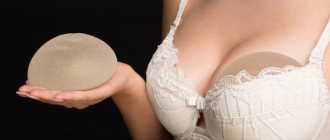Breasts are not only a source of pride for women and lust for men, but also an important part of the reproductive system. At the same time, according to statistics, every third inhabitant of the planet sooner or later faces diseases of the mammary glands. Any hormonal imbalance can lead to a pathology that requires immediate treatment. That is why it is necessary to find the slightest problems in the body in time and “fix” them.
For every representative of the fair sex who wants to stay healthy, in addition to an annual visit to the doctor, it is extremely important to regularly conduct self-examination of the mammary glands.
Question 1. What is harmful to breasts?
The content of the article
In fact, several factors pose a danger:
- Abortion. This is especially true for women under 18 years of age;
- Menstruation occurring before age 10;
- Late childbirth;
- Menopause starting after 55 years;
- Heredity;
- Deficit of sexual life;
- Stressful conditions;
- Obesity of any degree;
- Liver diseases;
- Excess animal fats in the diet.
This means that almost any woman can develop cancer. Therefore, it is so important not to forget about regular examinations.
Everything you need to know about breasts and their size
Regardless of breast size, your bust needs to be properly cared for to keep it beautiful and healthy. Breast development depends largely on genes and hormones, but breast care also affects breast shape, appearance and health. Learn about breast structure and what affects breast shape and size.
The structure of the breast is written by genes
Your ancestors' genes influenced the size or shape of your breasts. It is the genes that are responsible for our appearance, eye color, physique and breast shape.
People with the so-called apple silhouette, that is, with an endomorphic body structure, usually have a round face, short legs, small feet and a delicate skeletal structure. This body type tends to accumulate belly fat and tends to be overweight. People with this figure usually have large breasts.
Women with the so-called pear silhouette, or mesomorphic shape, are usually characterized by a square or oval face, legs the same length as the torso, and wider hips and shoulders. In such people, fatty tissue accumulates on the thighs and buttocks. Pear-shaped breasts are typically oval, can be apple-shaped, and are fairly average in size.
The last type of body structure is called a pole, i.e. ectomorphic silhouette. Women with this body type usually have an oval or heart-shaped face. They are characterized by a strong build, long legs, a shorter torso and large feet. Their fat tissue is evenly distributed and their breasts are small and slightly triangular in shape.
What determines bust size?
Breast size is greatly influenced by hormones, which can change the shape and size of breasts not only during puberty, but also later during menstrual cycles or fertile years.
During puberty, the ovaries begin to produce estrogen, which causes fat to accumulate in the connective tissue of the breasts. As a result, the breasts begin to enlarge. However, insulin and correct levels of thyroid hormones are necessary for their proper development. During this stage, milk ducts also develop.
Another life stage that affects breast development is pregnancy. In this condition, hormones secreted by the pituitary gland, ovaries and placenta prepare the glandular tissue of the breast to produce milk. This is mainly due to progesterone, prolactin and estrogens. Another hormone (oxytocin), which is produced by the posterior lobe of the pituitary gland, regulates the secretion of milk from the mammary glands.
The final stage affecting the structure of the breast is menopause. During menopause, sex hormone levels decrease and the glandular tissue in the breasts gradually disappears. In women prone to weight gain, glandular tissue is replaced by fatty tissue, so the decrease in breast size is practically not felt. Unfortunately, such breasts already lose their firmness and gravity is involved, causing the breasts to sag significantly after menopause.
Breast structure - how do menstrual cycles affect breast size?
With each menstrual cycle, most women's breasts become larger, swollen, and tender. All thanks to estrogens, which take on a leading role in the body 3-4 days before the first bleeding. The decrease in progesterone and the predominance of estrogen causes the body to retain water, which leads to more tension and enlargement of the nipples.
After menstruation, the level of sex hormones drops, so the changes begin to change. Thus, the water is lost and the breasts return to normal.
Menstruation has a big impact on breast development, so it is worth having regular tests, both self-exams and mammograms. Breasts should always be examined after your period.
Breast development begins in the womb
Even before it is known what gender the baby is, his breasts are already forming. Formation is estimated to begin around the 6th week of pregnancy. First, the skin thickens, that is, the so-called milk plate. It extends from the chest to the groin. As the fetus grows, most of the lamina disappears, leaving only two glands that later develop in the breast.
Then, only in the female sex, from each embryo, rows of cells grow deeper into the chest, which will eventually become mammary glands. This stage occurs around the 6th month of pregnancy.
At the turn of 10/11, intensive breast development begins. At the beginning of this period, the areola swells and the breasts slowly begin to enlarge.
Nipple skin, size and design
The breast is made up of glandular tissue, milk lobes and ducts, and the connective tissue that supports them. The ducts converge around the nipple, which eventually widen to form what is called the mammary sinus. This is the working part of the mammary gland, which is protected from injury by a large amount of adipose tissue. Its amount affects the size of the breast.
The nipple integument is the dark, flat ring of skin surrounding the nipple. Sometimes the areola is covered with small projections. The papilla is bounded by small muscles that begin to contract when the temperature changes or when touched. As a result, the nipple lengthens and hardens, and the areola begins to wrinkle.
The breast is abundantly supplied with blood, as the axillary artery, internal mammary artery and jugular vein are located nearby, which makes the bust sensitive to changes in temperature, pressure or injury.
Breast Medical Exams
To keep your breasts healthy, don't forget about regular checkups! At the age of 20-29 years, self-examination should be performed monthly. It is better to do this after menstruation. You should visit a doctor every year, and after 25 years you should do a breast ultrasound.
Women 30-35 years old should also remember to perform monthly self-exams, annual doctor visits, and ultrasounds. After age 35, you should have an annual mammogram. Women aged 36-49 should also undergo monthly self-examinations and make an appointment with a doctor every 6 months. They should have an ultrasound once a year and a mammogram every two years after age 40.
Ladies aged 50-56 still cannot forget to take monthly self-tests. They should see a doctor every 6 months and have an ultrasound and mammogram once a year.
Women over 65 should also undergo monthly self-exams. They must make an appointment with a doctor once a year and have ultrasounds and mammograms every two years.
Different breasts
No two breasts are completely equal. Asymmetry is a natural thing, in some women it is barely noticeable, in others it may be more. The left breast will always be different in size from the right, which is natural. These differences are usually small, so most women don't even notice them.
However, there are cases when the difference is significant, then this can become a problem for the owner of a bust. Sometimes it is enough to adjust the size with a special bra insert. However, if the disproportion is noticeable and the woman feels unwell, she can undergo plastic surgery.
Nowadays, there are many methods of breast enlargement. Your doctor may also perform breast reduction. It doesn't always have to end on the operating table under full anesthesia. There are surgical and less invasive procedures. You can increase them with implants, saline, or even your own fat.
However, remember that if breast asymmetry appears suddenly and one of them increases significantly in a short time, be sure to consult a doctor! This may indicate an ongoing disease process that requires immediate monitoring!
To keep your breasts beautiful, healthy and firm, you need to take care of them. Unfortunately, many women do not know how to properly care for their breasts, do not choose the right bras, adopt incorrect posture, not to mention caring for the delicate skin of their breasts. It is worth learning more about your breasts and caring for them carefully. After all, this is the realm of femininity, a symbol of sexual attractiveness and grace. So take care of your breasts, not forgetting about regular examinations!
Question 2. How to avoid breast cancer?
The main thing is early diagnosis, which gives a chance for a full recovery if the disease is detected. Prevention is a timely examination.
- Self-examination at home .
Every month, a woman should independently examine and feel her mammary glands for any changes. This could be lumps, deformation, discharge from the nipples, retraction of the nipples, or enlarged lymph nodes in the armpits. All this should be done on days 4-5 of the menstrual cycle. If menopause has already arrived, then the breasts are examined on the same day every month. - Examination by a mammologist.
Two examinations are required for women - ultrasound of the mammary glands and regular mammography. Young women under 40 undergo ultrasound, older women undergo mammography. At the age of 30–35 years, examinations should be carried out once every 3–5 years, at 40–50 years old – once every 2 years, after 50 years – annually.
Breast self-examination
Heredity factor as a sign of cancer
One of the mandatory actions in relation to a patient with breast cancer is to build his family tree and determine the need for genetic testing for the presence of BRCA genes . BRCA1 and BRCA2 are autosomal dominant genes that can be a sign of the development of breast cancer in up to 80% of relatives. There are several reasons to suspect the presence of these genes in the family:
- cases of cancer at a young age ;
- bilateral breast cancer , when after one breast is affected, the tumor forms in the second after some time;
- cases of breast cancer in men.
All of the above factors are a reason to conduct genetic testing to build a family tree for three generations and determine the mathematical probability of carrying the BRCA genes. Siblings and children of a carrier woman have a 50% chance of inheriting the gene . Thus, genetic testing is an effective method for preventing breast cancer.
Question 4. Why do my breasts hurt before menstruation?
Pain that occurs only when menstruation occurs does not pose any threat, and is a common occurrence in women. Thus, the breasts react to changes in hormonal levels. This is explained by the fact that about a week before the start of menstruation, a rush of fluid to the mammary glands begins.
If the pain does not bother you much, then there is no need to worry. Otherwise, you need to visit a gynecologist to prevent diseases such as mastitis, mastopathy, etc.
Among other things, pain in the mammary glands can be caused by pathology of other organs (gastrointestinal tract, thyroid gland, etc.). If the mammary glands hurt constantly or not in conjunction with menstruation, you should immediately visit a gynecologist.
Cost of breast cancer treatment
The duration of treatment at Ikhilov for breast cancer on an outpatient basis is 3-4 working days.
Prices for cancer treatment set by the Israeli Ministry of Health at the Ichilov Cancer Center:
| Breast cancer treatment procedures | Price |
| Breast biopsy | 1761$ |
| Examination by the leading oncologist of the oncology center | 512$ |
| Mammography | 246$ |
| PET-CT | 1488$ |
| Ultrasound of the mammary glands | 408$ |
| Chemotherapy course | 1270$ |
| Segmental mastectomy | 5308$ |
| Sectoral mastectomy | 13211$ |
| Bilateral mastectomy | 10231$ |
| Mastectomy unilateral | 7750$ |
| Radiation therapy | 17007$ |
You can take the first step towards recovery right now. To do this, fill out an application and one of our doctors will contact you within 2 hours.
Or call: +972-3-376-03-58 in Israel and +7-495-777-6953 in Russia.
Question 6: Is stress related to breast health?
Many people have no connection between nervous tension and the health of the mammary glands. But there is a lot in common between them. During stress, the hormonal balance is disrupted, which can lead to the absence of menstruation and the development of diseases such as uterine fibroids, mastopathy, polycystic ovary syndrome and oncology.
Why is it worth treating breast cancer in Israel, at the Ichilov Cancer Center?
- Accurate diagnosis.
The latest diagnostic methods, including PET-CT and sentinel lymph node biopsy, allow Israeli specialists to accurately determine the stage of the disease and select the correct treatment program. - World-famous doctors and a personalized approach to treatment.
At the Ichilov Oncology Center, breast cancer treatment is carried out by leading Israeli oncologists, including Professor Moshe Inbar, a doctor with 40 years of experience and the author of more than 20 scientific papers. The professor selects individual treatment protocols for patients that correspond to the characteristics of the disease. - The latest equipment.
The oncology center uses the following for the treatment of breast cancer:
- linear accelerators Synergy S and Novalis TrueBeam STX, which allow delivering high doses of radiation to the tumor, while protecting healthy tissue from radiation;
- Marginprobe is a device that makes it possible to remove a tumor with “clean edges.”
When do you need to see a mammologist urgently?
Any changes in the mammary glands - discharge, pain, the appearance of tumors, deterioration of the skin - is a reason to immediately make an appointment with a mammologist. Breast cancer is easily treated only in the first stages. Advanced tumors require removal of the mammary glands, and if the cancer has spread, other organs.
ONLINE REGISTRATION at the DIANA clinic
You can sign up by calling the toll-free phone number 8-800-707-15-60 or filling out the contact form. In this case, we will contact you ourselves.
Control your diet
It is advisable to include foods rich in vitamin C in your daily diet: lemons, kiwi, bell peppers, cabbage. And also regularly eat carrots, tomatoes, dill and spinach, which contain vitamin A - it increases antitumor resistance. Vegetable oil and cereals contain vitamin E, they prevent the appearance of tumors and slow down the aging process. The trace element selenium plays an important role in the prevention of breast cancer. It is able to selectively accumulate in tumor cells and prevent their destructive activity. Therefore, include seeds, garlic, shrimp and fish in your diet.
TNM stages
All over the world, the classification of breast cancer according to TNM is accepted, which includes the size of the tumor, the condition of the lymph nodes, and the presence or absence of metastases. The TNM staging system provides complete information about tumor development:
- the letter T – indicates the size of the malignant formation;
- the letter N is a description of the spread of cancer to the lymphatic system;
- the letter M is a description of the spread of the tumor to other tissues and organs.
Causes and risk factors
Every year in Russia alone, malignant tumors in this organ are detected in 50 thousand women. And worldwide this number exceeds a million. And the survival statistics are also disappointing so far. Almost half of the cases in women are fatal. Risk factors that can trigger tumor development include:
- hormonal imbalance;
- childlessness and having many children;
- very late first birth;
- frequent abortions;
- early onset and late cessation of menstruation;
- presence of mastopathy;
- age over 40 years;
- addiction to smoking and alcohol;
- obesity, as well as frequent stress;
- hypertonic disease;
- inflammation of the uterus and ovaries;
- atherosclerosis;
- hypothyroidism;
- liver diseases.
But it happens that cancer is discovered in patients who are not included in any of these risk groups.
Treatment of mastopathy
Treatment of mastopathy that meets modern requirements can only be prescribed by a mammologist. To make a diagnosis, he uses modern imaging methods, namely mammography and ultrasound. He also determines the indications for surgical interventions, because some nodes have to be removed.
General treatment of fibrocystic pathology of the mammary glands is aimed at eliminating risk factors, but the most important goal of such treatment is the normalization of hormonal levels. And for this it is necessary to normalize lifestyle, habits and even nutrition, because all this has a very significant effect on the production of hormones.
One of the key roles in the treatment of fibrocystic pathology is the treatment of mastopathy with hormones. The tactics of hormonal therapy are developed individually for each woman. However, after discontinuation of hormonal drugs (and their discontinuation is necessary no later than 6 months after the start of treatment), a relapse of the disease may occur. In addition, there are many contraindications for hormonal therapy, such as diabetes, venous and liver diseases.
That is why non-hormonal drugs of plant origin have recently become increasingly relevant. Developed on the basis of MMA named after. Sechenov, the drug Indinol acts selectively on cells affected by pathology. It launches a self-destruction program in them, leaving healthy tissue untouched.
Being non-hormonal, Indinol normalizes hormonal levels, stopping the development of the disease. The difference between this drug is that mastopathy does not recur after completion of the course of treatment. The plant origin of Indinol makes it highly safe.
The course of treatment with Indinol is 6 months. This drug ideally complements hormonal and surgical treatment methods, but can also be used as monotherapy. The complex effect of Indinol is not symptomatic, but etiological - this drug acts directly on the cause of the disease.











